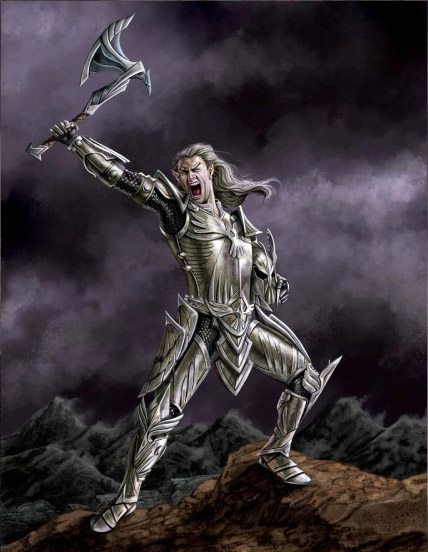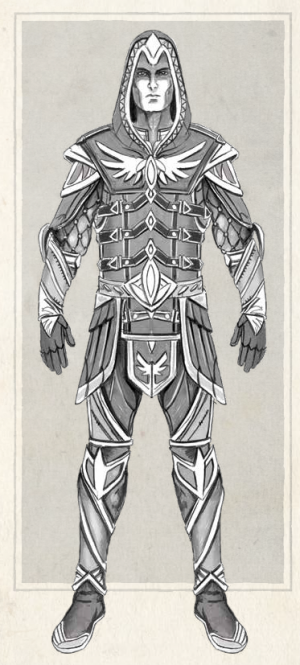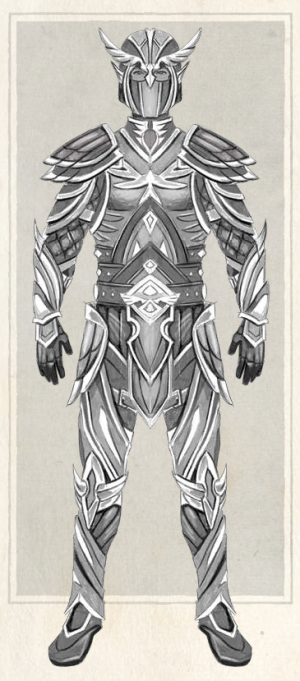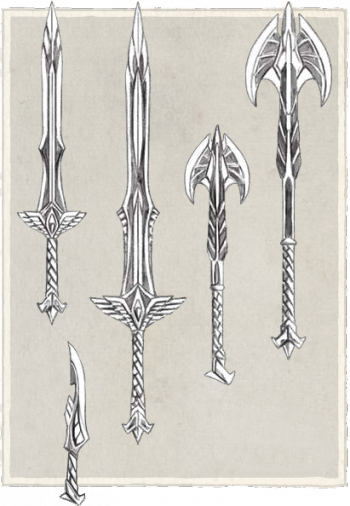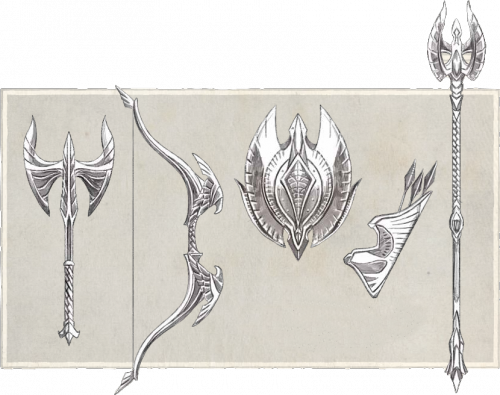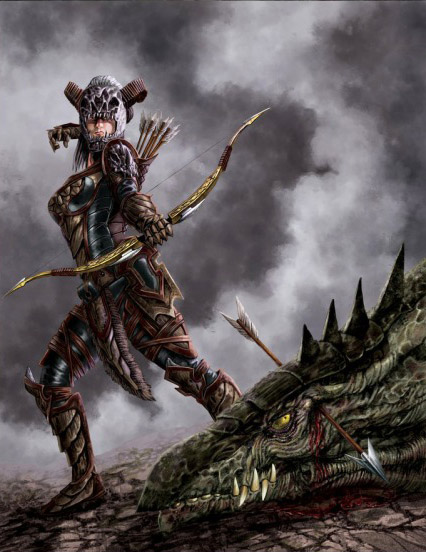Utilisateur:Destroy/bac-à-sable/Regroupement de force/Chapitre 1
Auteur réel : David S. J. Hodgson (É), Caio Cacau (Artiste) Média d'origine : The Hero's Guides to The Elder Scrolls Online
Par Longinus Attius, 2E 581
I L FALLU QUELQUE douce, ronronnante persuasion de la part du champion Khajiiti, Zadabal-ra, pour convaincre les distants habitants à la peau dorée de l'Archipel-de-l'Automne de prendre part à notre réception guerrière. Mais part ils ont pris, portant une caravane de boucliers éclatants, heaumes ailées, et lances dédiées à Phynaster le Guardien. Pour autant, nous, incultes barbares du continent, avions à siéger jusqu'au bout de copieux verbiages concernant nos lacunes au combat, ce qui failli mener le champion Nordique vers une violente, bouillonnante, éruption de colère. Les tempéraments furent donc testé avec de l'hydromel et quelques féroces combats d'entraînement, où les fluides et élancés styles des armes de guerre Aldmeri - fines et ciselés comme leurs navires - furent finalement examinées.
L'armurerie Altmeri dispose d'une solide élégance que bien d'autres ont tenté et échoué à atteindre. Même le plus modeste Altmer éprouve un dédain pour le fer, l'acier, ou tout autre matériau des vulgaire continentaux, de bien plus exotiques minerais et minéraux font partie du processus de forgeage, ce qui peut être convoluté à leurs styles de discours. Alors que les extravagants matériaux ont érodé les plus communs, le verre est sans doute le plus impressionnant quand les épées où les haches sont formées de cette collection de résines et dépôts volcaniques. Le résulta est surprenamment robuste, mais toujours séduisant dans sa forme. De telles armes sont bien pondérées, d'un vert lacté, mais les lames requièrent un affûtage constant et attentionné. La quantité de minéraux rares (et le plus souvent cristallins) que l'Archipel-de-l'Automne cache sous ses riches sols est accordée à l'amélioration d'une variété de magnifiques armes manufacturée. L'un peut agir sur une lame longue enchâssée de détails vitreux, d'un pommeaux doré, et stylisée avec ailes et têtes d'aigles. Un autre pourrait dessiner l'arc ailé d'un Haut-Elfe, tout en rendant sa souplesse comparable à celle de la cuisse d'une vierge. Les Altmers ne chassent pas les animaux pour une prise ou un travail de finition, préférant l'abattage d'un guar d'élevage pour fournir le cuir le plus malléable à un manche de hache. Le résultat est une stupéfiante balance de délicatesse ornée et d'un tranchant sinistre.
T HE BOSMER HAVE A rather amusing wonderment for nature, and were this simply a predisposition to frolicking in the forests, I would have no cause for concern. But the Wood Elf's veneration for the dappled sapling and the delicate moss extends to an almost crippling disregard for cultivation
and management of their bounteous resources. For despite king surrounded by the finest graht oaks in the land, no Bosmer is permitted to craft arms or armor from plants. However, just as they enjoy the fermented pig's milk of Jagga and the smoky intoxication of dried caterpillar, there are ways to solve the riddle of the Green Pact. Without wooden arrows or shields, a Bosmer will descend upon animals like a rabid skeever on a shipmate's toe. Beware the curse of being a forest creature in Valenwood, as your life is likely to be brief, and your corpse parts skinned, flayed, fiddled with, and generally put to use; there are never remains for the maggots. Expect to see a Wood Elf clad in leather, shell plates, and occasionally antlers, with skulls for helms and other bones for fancy ornamentation. For more robust protection, strange insect resins and equally odd alchemical additives are combined to color and stiffen the plackart and fauld. As forge fires are banished from the realm of the Bosmer, hand weapons made from metal are rarely used within Valenwood. When a bow is out of reach, expect an axe, spear, or blade shaped from jagged glass or flint stone, grasped with a primitive hand holding a primitive bone handle. No, it is the bow for which the Bosmer craftsman is rightly revered: Cunning concoctions of honey vinegar, brought to the boil before other secretive elements are added, improve the flexibility of the bone stick, and the time submerged greatly affects the form of the stick. Until the recent truce, most bowstrings were fashioned from Khajiiti gut. The arming of a Wood Elf involves the polishing of flint, the melding of metal, the chiseling of bone, and the fusing of glass into elegant shapes. Or the purchasing of a wooden weapon crafted by another race.
M UCH IN THE WAY a Redguard favors a billowing flow of cloth, a Khajiit prefers armor that is both lightweight and hard wearing, due to the swelter of both the Khajiiti homeland and the naturally thick coats they refuse to shave. But the incessantly arid landscapes of Elsweyr tell only part of the story, for the cat folk hiss and spit at coverings that might encumber them, and claw away at armor seen as a restraint to their natural agility. Perhaps the only moment one will spy a Khajiit clad inthe heaviest of protection is just prior to a regimented war, which the cat does not favor.
Devotion to the moons is at the forefront of any embossment or augmentation of Khajiiti attire, and shields and plate armor are no exception. Certain shields are crescent shaped, to aid in both the veneration of Maser and Secunda, and in the swift stabbing motion through the shield's gap favored by the dagger-wielding warrior. Expect what armor that is worn to be made of lacquer& segments, sometimes encrusted with horn and seal onto loose-fitting leather. Some Khajiit shun metal completely, nuzzling instead against quilted and brightly patterned cloth. Striped tunics with fancy embroidery show indigenous skill, which extends to the fluted silver edging of more ceremonial armor pieces. Even the most cumbersome and weighty protection of a Khajiit is particularly unsubstantial in nature when compared to that of a Nord or, especially, an Orc. This is gossamer attire, with only vulnerable elements such as greaves and gauntlets receiving special attention. Instead, expect loose shawls, ribbons, and other trinkets to form decoration. But do not mistake their weapons for anything more than a collection of extremely sharp and ferocious slashing implements. While longbows and javelins are brought for hunts, the cat folk relish in supplementing their own claws with a wide variety of fiendish blades, ranging from the smallest punch dagger and smaller knives, to the curved scimitar blade. When caressing a Khajiiti weapon of war, one must be careful not to catch oneself on a pointed edge. It is rare to chance upon a Khajiiti weapon that doesn't feature a curved edge or a symbol of the waxing or waning moon.
|
